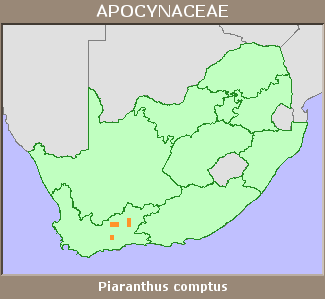|
Scientific Name | Piaranthus comptus N.E.Br. |
Higher Classification | Dicotyledons |
Family | APOCYNACEAE |
Synonyms | Piaranthus comptus N.E.Br. var. ciliatus N.E.Br. |
National Status |
Status and Criteria | Least Concern |
Assessment Date | 2019/11/05 |
Assessor(s) | D. Raimondo & D.A. Kamundi |
Justification | Piaranthus comptus is an endemic species to the Great Karoo Escarpment north of the Swartberg Mountains with an extent of occurrence (EOO) of 23 853 km². This species occurs widely in suitable habitat and is not currently threatened. With 26 recorded subpopulations and many more unrecorded subpopulations likely, this species is listed as Least Concern. |
Distribution |
Endemism | South African endemic |
Provincial distribution | Northern Cape, Western Cape |
Range | This species is endemic to South Africa, and is found from Beaufort West to Laingsburg and Willowmore. |
Habitat and Ecology |
Major system | Terrestrial |
Major habitats | Western Little Karoo, Prince Albert Succulent Karoo, Eastern Upper Karoo, Gamka Karoo, Southern Karoo Riviere, Gamka Arid Thicket |
Description | It occurs in gravelly flats under bushes. |
Threats |
| Large-scale shale gas fracking was proposed in 2015 for the Karoo basin covering the majority of this species' range. Subpopulations on flats would be most vulnerable to habitat loss to infrastructure development related to fracking, and this species would decline in future if fracking goes ahead.
A Strategic Environmental Impact Assessment submitted to South Africa's Department of Environmental Affairs in 2016 cautioned against moving ahead with Shale Gas fracking based on the very high infrastructure costs associated with fracking as well as multiple secondary negative impacts both to biodiversity and other economic activities in the region. Furthermore geological studies that have taken place since 2016 have found that gas deposits are not as substantial as originally suspected due to the very old age of the Karoo shale formations and the dolerite intrusions that occur throughout the Karoo having resulted in much of the gas being lost. At present, future development scenarios are too uncertain to estimate the potential extent of the impact on the population but it is unlikely that shale gas fracking will proceed in the near future. |
Population |
There is no information available on the population of Piaranthus comptus.
|
Population trend | Stable |
Assessment History |
Taxon assessed |
Status and Criteria |
Citation/Red List version | | Piaranthus comptus N.E.Br. | Least Concern | Raimondo et al. (2009) | |
Bibliography |
Goldblatt, P. and Manning, J.C. 2000. Cape Plants: A conspectus of the Cape Flora of South Africa. Strelitzia 9. National Botanical Institute, Cape Town.
Raimondo, D., von Staden, L., Foden, W., Victor, J.E., Helme, N.A., Turner, R.C., Kamundi, D.A. and Manyama, P.A. 2009. Red List of South African Plants. Strelitzia 25. South African National Biodiversity Institute, Pretoria.
Snijman, D.A. 2013. Plants of the Greater Cape Floristic Region 2: The extra Cape flora. Strelitzia 30. South African National Biodiversity Institute, Pretoria.
|
Citation |
| Raimondo, D. & Kamundi, D.A. 2019. Piaranthus comptus N.E.Br. National Assessment: Red List of South African Plants version 2024.1. Accessed on 2025/11/15 |
 Comment on this assessment
Comment on this assessment


